Tracking Termites Part 1
This is a two part article. The first part discusses why we should all become DIY inspectors and where and how to look for termites. Part two, to be published in the next newsletter, looks more closely at what it is you are looking for.
Every investor or home buyer should learn to look for signs of termites when inspecting a property. Too many people dismiss this activity in favour of employing the experts, but there are times where it just wasn’t necessary to get as far as that – the termites were there, they were obvious, you aren’t interested in buying a property with termites and yet you have just wasted a lot of time and money by not knowing the basics. We aren’t advocating the replacement of the experts: regardless of whether you find any evidence of termites you should always have an expert carry out a thorough pest and building inspection. What we are trying to do is get you to be smarter with your time and money by only getting as far as the experts on properties that pass your initial inspection. After all, why get them out to tell you something that you really should have known already?
I am not a licensed building or pest inspector, which makes it all the more relevant. I am someone who buys property for people for a living as a buyer’s agent and as such has a duty to minimise costs in both time and money for my clients, hence the need to take a thorough look for pests when making an inspection. My time is also valuable, so I am not interested in pursuing a property that is likely to fail the building and pest inspection, unless of course that is part of the strategy!
Termites are a part of life - don't run away at the first sign of them!
The first thing we must do is accept that termites do exist and exist in vast quantities right round Australia, although Tasmania and parts of Melbourne experience very low levels, as can be seen by the CSIRO’s ‘Termite Hazard Map’.
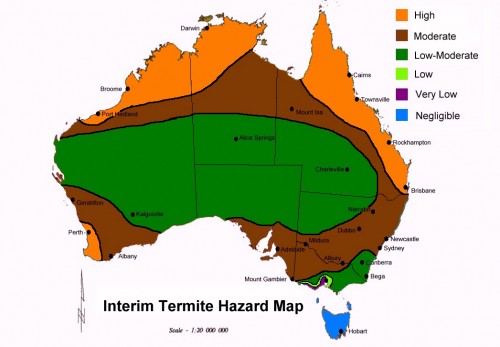
'Termite Hazard Map, CSIRO, 2002.
Termites don't care if you have a brick house!
The other thing you must be aware of is that termites can attack any dwelling type. Being a Brisbane based buyer’s agent I look at many timber dwellings and one misconception I hear all the time is that weatherboard homes (i.e. the ‘Queenslander’) are at high risk from termite attack. This isn’t quite accurate. Yes they are at risk, but so is every other house. One big difference with a Queenslander style home is the majority are highset, so you can monitor termite activity and penetration into the dwelling. This is far more difficult to achieve in a brick and tile slab on ground house. Termites only need the smallest of cracks in the slab to enter the dwelling and the big problem here is they are concealed, so the first a lot of people know about them is when they have done significant damage. Even houses with termite barriers are at risk if treatment and inspections are not kept up or the barrier is somehow breached. It may be breached by plumbing or electrical works/installation, or by the build up of a garden bed against a house, or a moisture issue, or most common, man’s ability to provide a highway into the house by stacking timber against a dwelling. Modern houses are also largely pine framed, whereas older dwellings have far more hardwood, which while also susceptible to attack is far less attractive to a termite. It is like us being presented with a BBQ eye fillet steak compared with a fatty, BBQ casserole steak. A perfect example is when you do find a Queenslander that has been infested, the majority of damage is to more recent pine additions such as built in robes and cover strips.
When I inspect a property I seek out current or past termite activity as well as areas of dwellings susceptible to termite entry.
Here are some hints and tips of how and where to look:
- Wear clothes that you are happy to get a little dirty and don’t be afraid to inspect the under croft of a house and if possible, the ceiling space as well. Don’t forget your torch. If termites are in the ceiling, be very diligent and try to track how they got up there. For termites to be in the ceiling they have had to travel a long way.
- When under the house, look for tracks in cracks. Termites love dark areas, so they will always go between cracks before they will build a mud track that is exposed. In particular look in the cracks of stumps (both timber and concrete), between stumps and any timber attached to the stump (such as for attaching battening to) and between ant caps and the bearer.
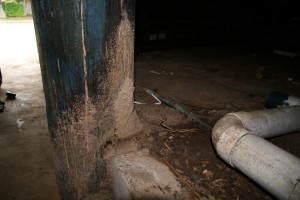
Not only have the termites gone up the crack of this timber stump, but they have also built a mound on the side. Do you think the ant cap stopped them? Think again, they had also built a mud pack around the ant cap. Notice the moist ground near this stump.
- Ant caps are designed to force a termite around the cap, making them visible. They are not designed to stop them from entering a dwelling. This is another commonly misunderstood item.
- In highset dwellings look for additions that may not have been part of the original house. These are normally garage doors (and associated timber supports), storage areas under the house and built in areas such as walls around the perimeter that would most likely have been battens to begin with.
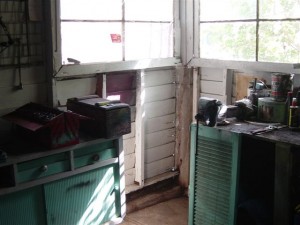
This is an enclosed area that someone has done after the house was built. The timber in the corner makes contact with the ground and then with the house above. This house was actually riddled with termites to the point where it was no longer safe. My client did not mind - he wanted to knock it over to access the two blocks of land under it! We hit a snag though, the financier got wind of the termites thanks to a comment made by the valuer and they refused to lend against the property. They wouldn't even lend 40% or against the land value, even though my client was knocking the house over!
- Look at gardens that are built up against the walls. In brick dwellings, ensure the garden bed is below the level of the weep holes and preferably below the level of the top of the slab. In timber houses ensure the garden is not against any of the timber at all.
- Look for timber stacked up against the house. This can be timber stored under the house, against the outside wall or believe it or not, something simple like a rake or broom leaning against the house.
- In any type of house but in particular slab on ground houses, check to make sure that no part of the externals are built above the termite barriers. A prime example are driveways. Traditionally the house is constructed on a termite barrier and the driveway is one of the last areas to be constructed. If this is constructed above the termite barrier you have effectively rendered the termite barrier ineffective in that location. Paved areas is another example. This exact scenario was the case with one brand new building recently. The result was that a chemical barrier had to be installed by drilling into the new driveway. The good news is that it was still covered under the builder's warranty.
- Look closely around wet areas. Termites love it moist!
- Look closely at parts of a dwelling built to the ground where the remainder of the house is highset. This is most commonly seen with laundry areas at the back of postwar houses and split level homes.
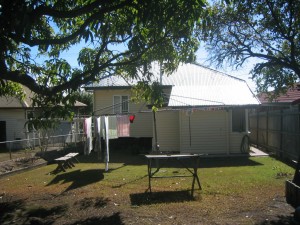
This is a highset house with a lowset laundry at the rear. Very common with 1950's houses. Depending on how well maintained the laundry area is, this can often be a gateway for termites into the highset house and a close look from all angles of this laundry area is highly recommended when inspecting a property.
- Look for trees growing against the house, especially if it has been cut down and is now just a stump.
- Look at timber, stumps and old logs lying around in the garden.
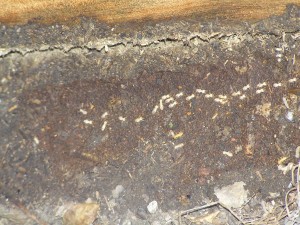
These termites were found under an old piece of timber behind a shed. Because it was the southern side of the shed there wasn't much light, so the area stayed fairly damp, which is very attractive for termites!
- Also look up! Some types of termites like to build their nests high.
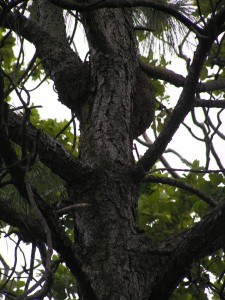
This termite nest was found very high up in a pine tree at the back of the 'Funky Flats'. Despite the termites the property was purchased and has proven to be a very good investment. Click here to read an article about the Funky Flats.
- If mainly a hardwood home look for areas of pine, usually in robes, kitchens, cover strips and window frames.
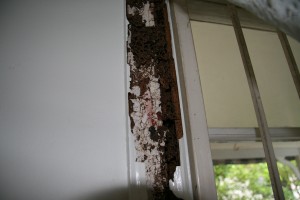
Believe it or not, we inspected this property two weeks apart and the damage was not there the first time around! A thermal image showed that they had bypassed the hardwood frame to reach the pine window trim. We still placed an offer on this property as it was a development site and we could see how the termites were getting in, how to prevent them from coming in again and this damage is very easy to fix.
- Look for past treatment. In houses on timber stumps look for drill holes about the size of a 5 cent piece in the stumps, which is where they tipped poison in years gone by. Also look for baits around the dwelling or in the garden or filled drill holes in concrete or paving that may be from a chemical barrier. Having baits and termite barriers in most cases is a positive as it means there has been a proactive (and rather expensive) approach taken when it comes to termites. Also look inside the meter box for a sticker indicating past treatment(s).
Next issue we look at what you are looking for with some real life examples that were picked up by Investigate Property before a building and pest inspection was carried out.
Investigate Property are buyer's agents of Investment Property in Brisbane. To find out more on how we can help to locate your next deal click here.
